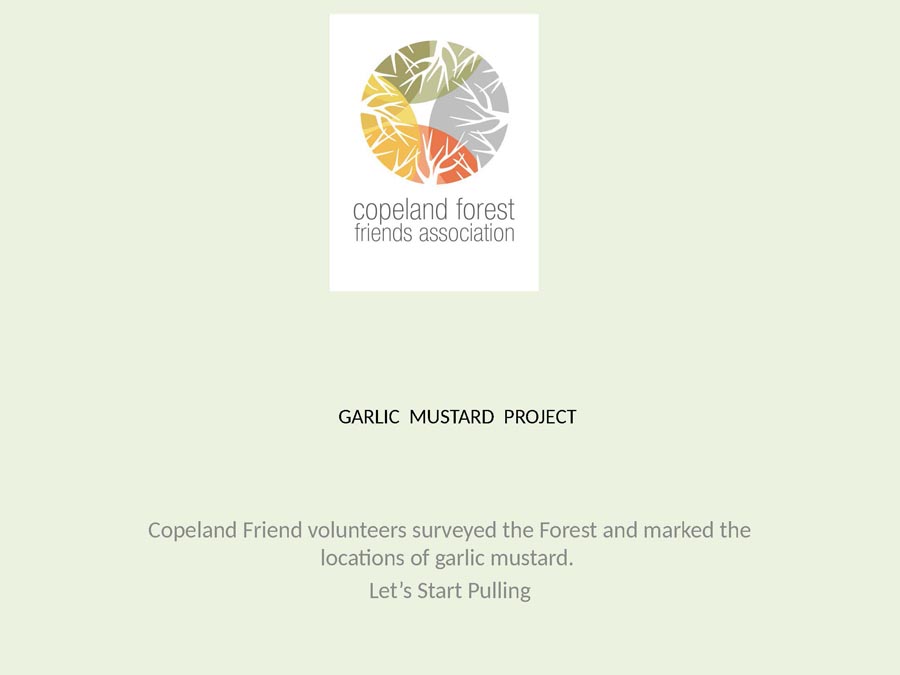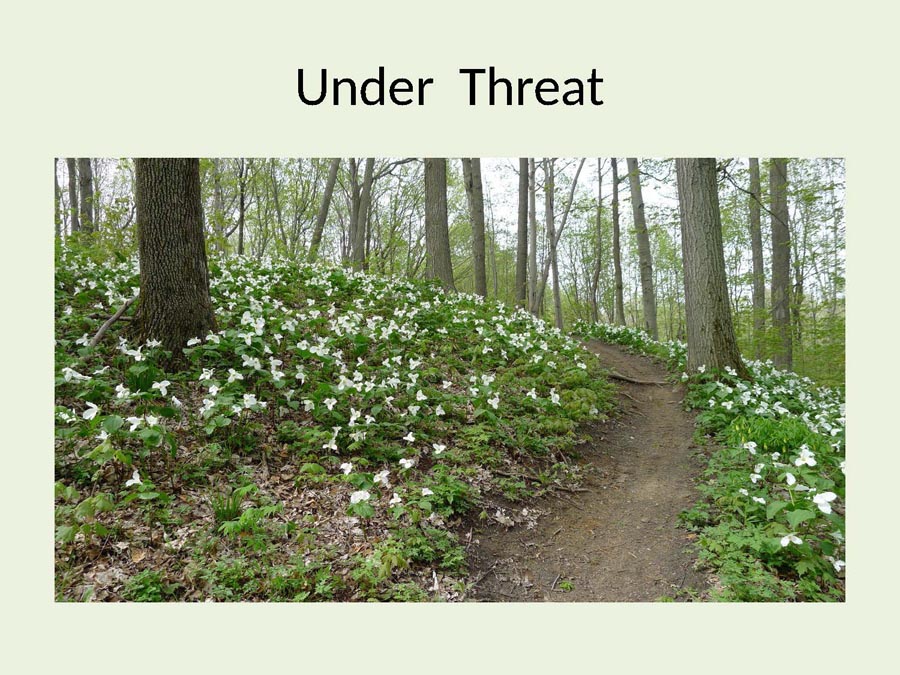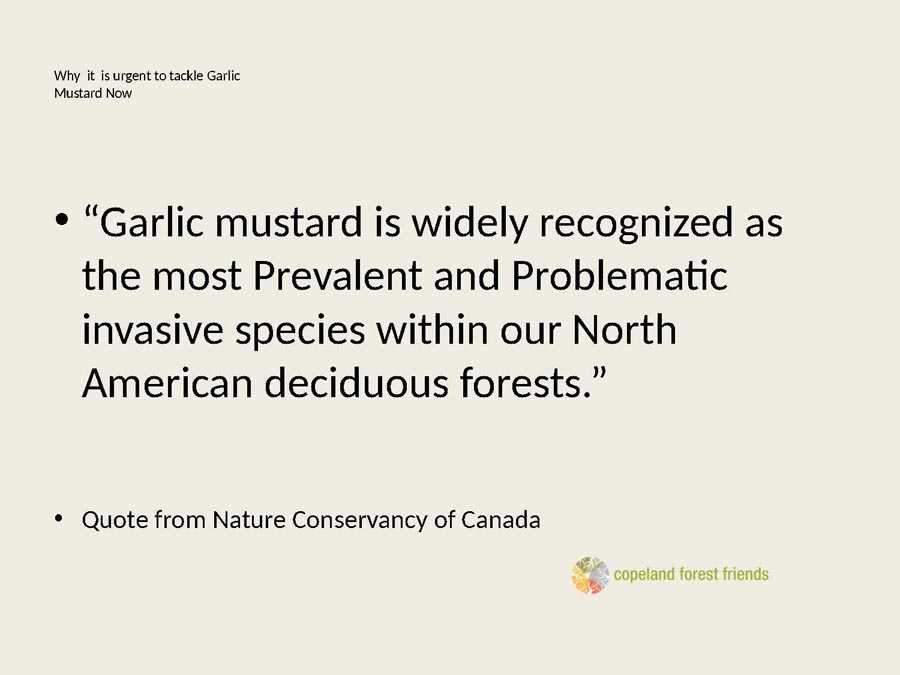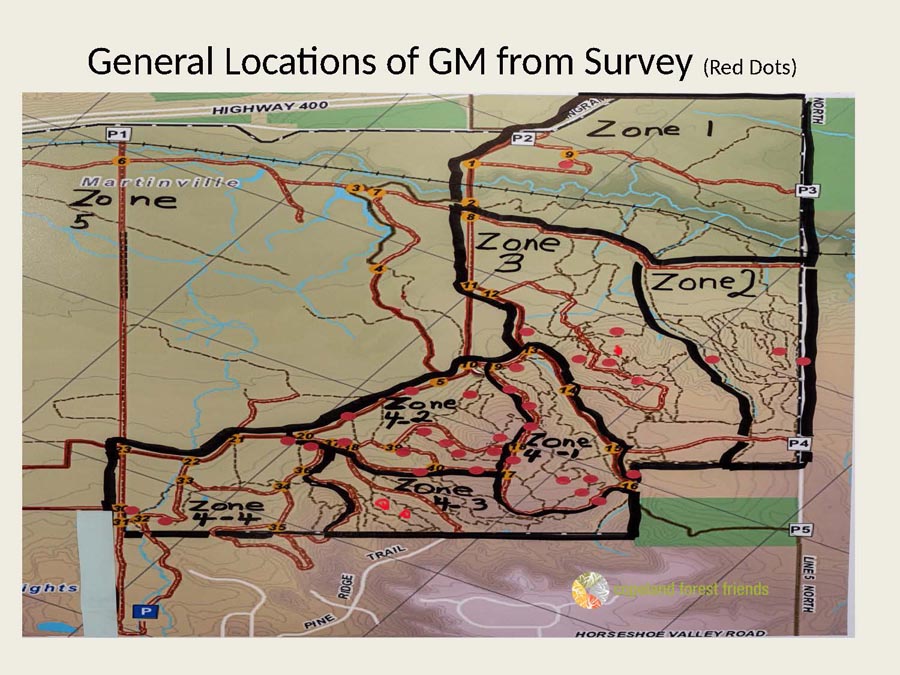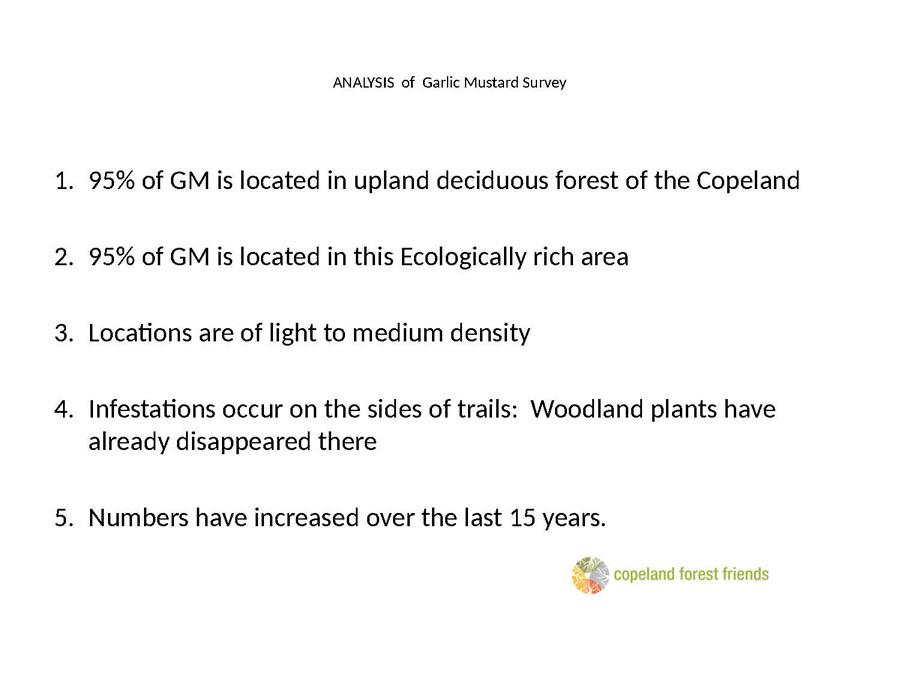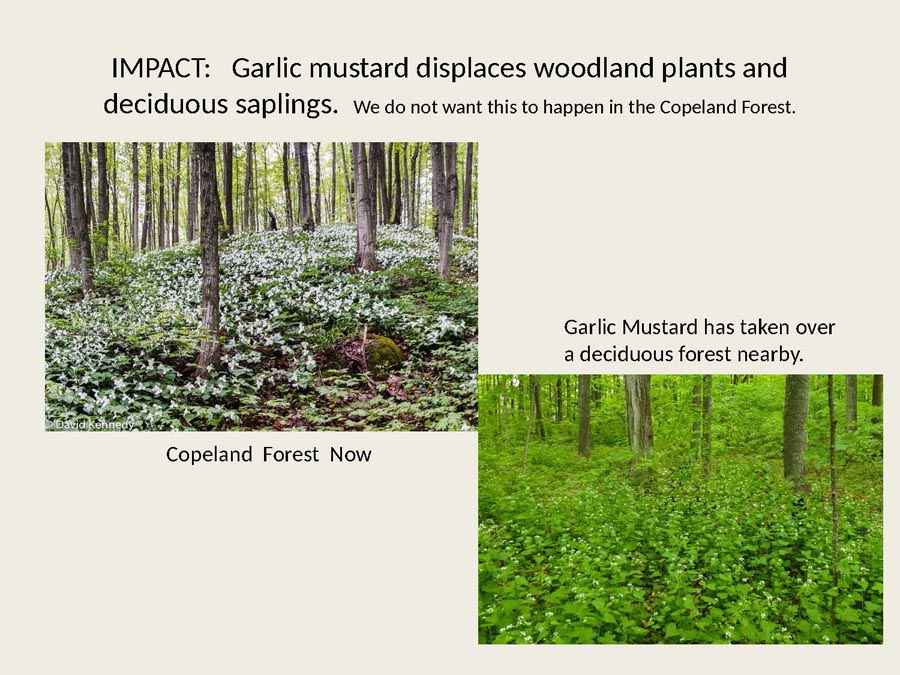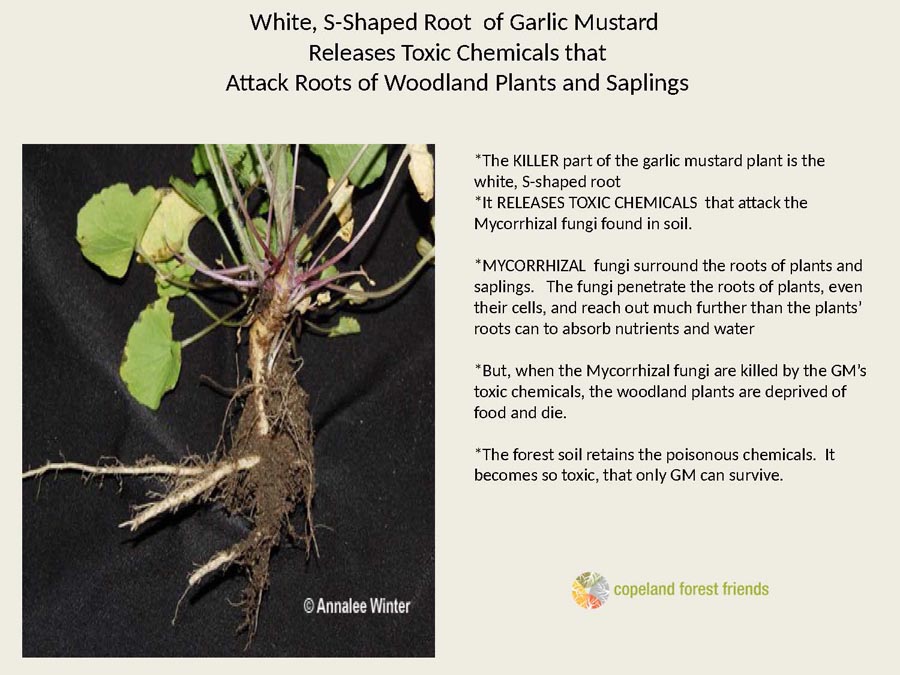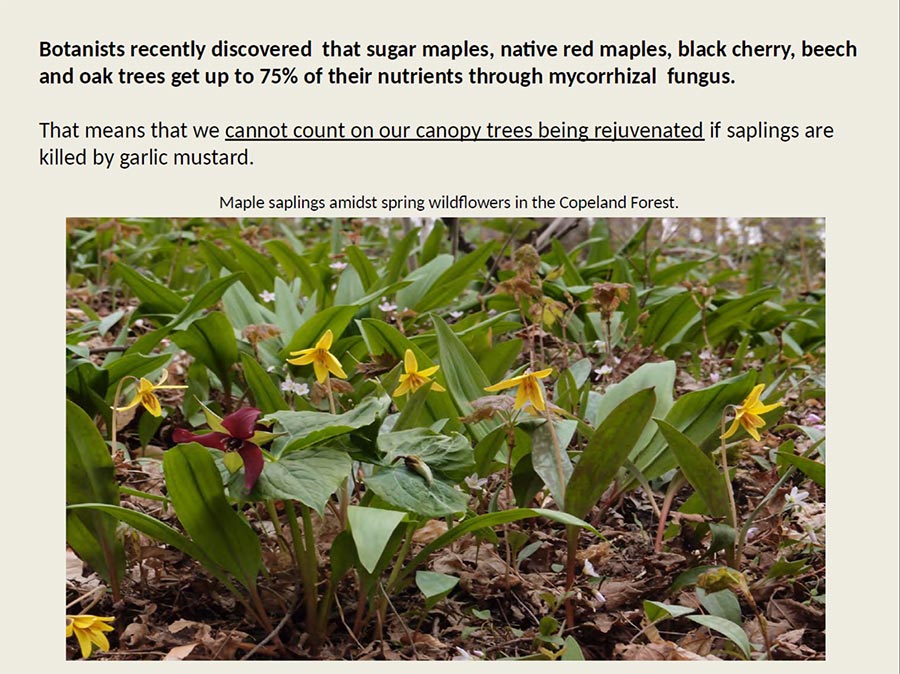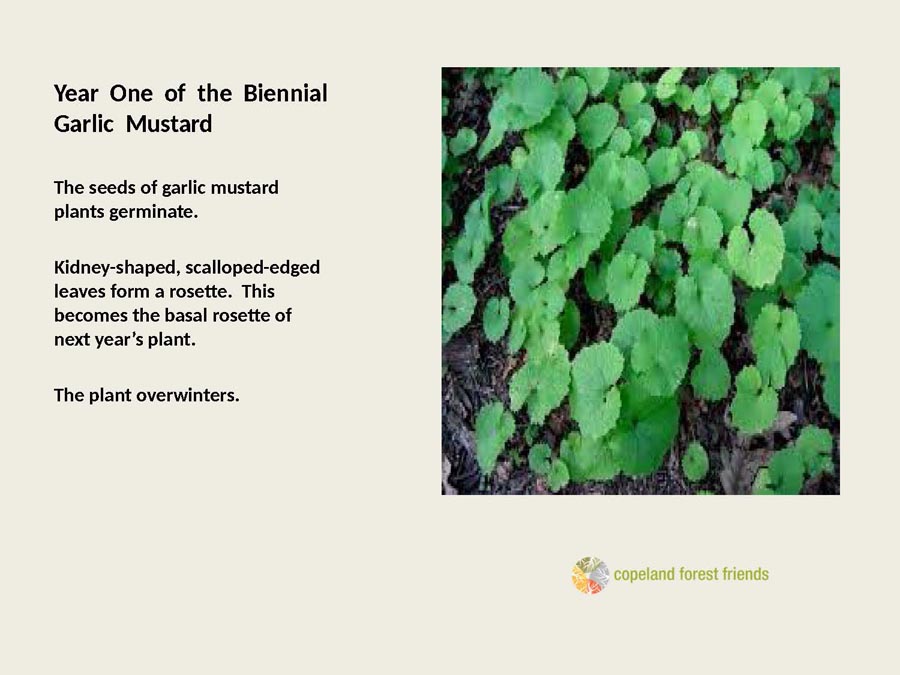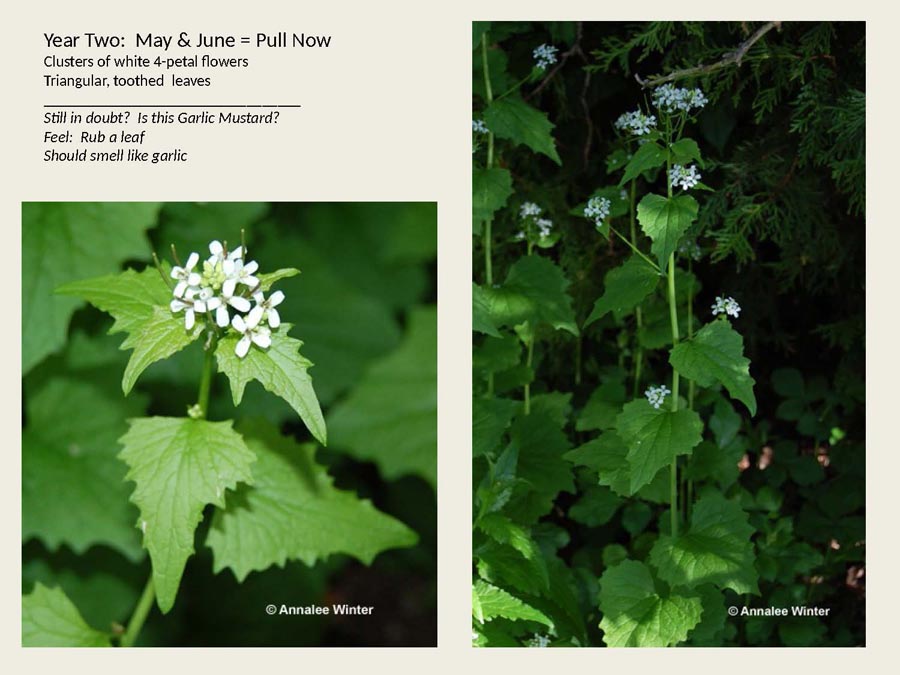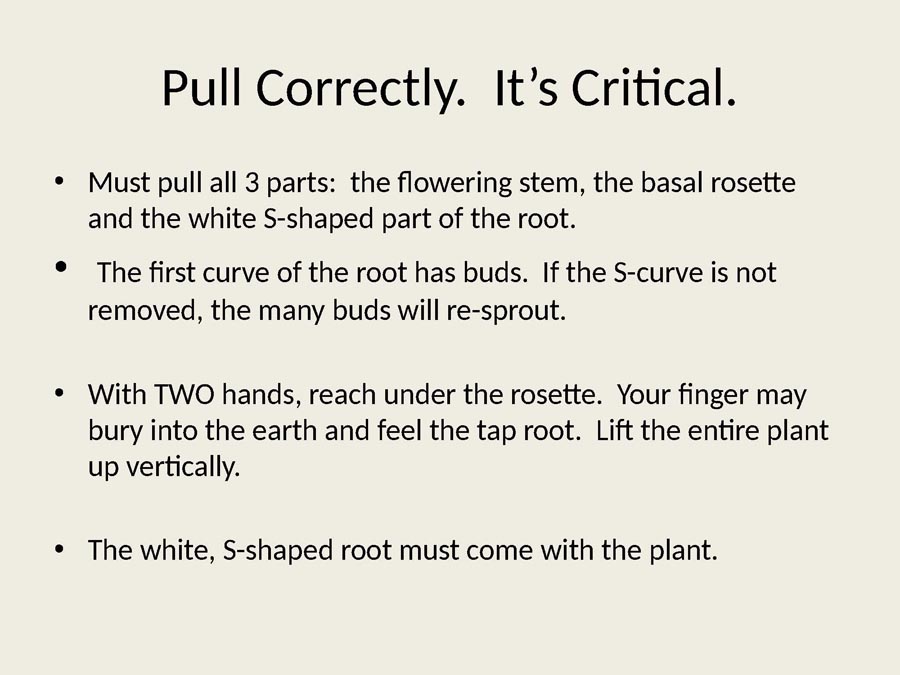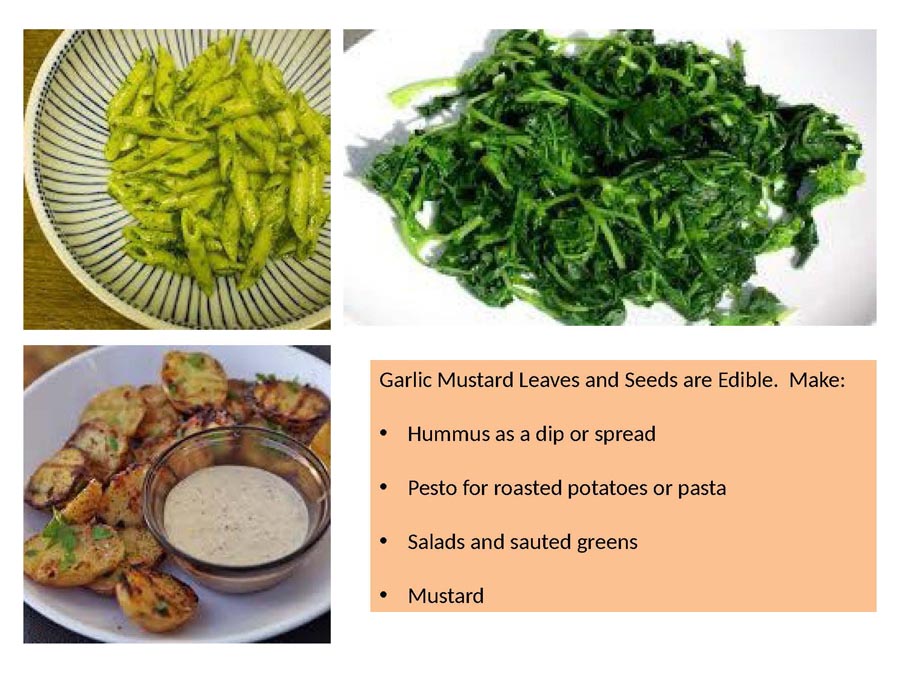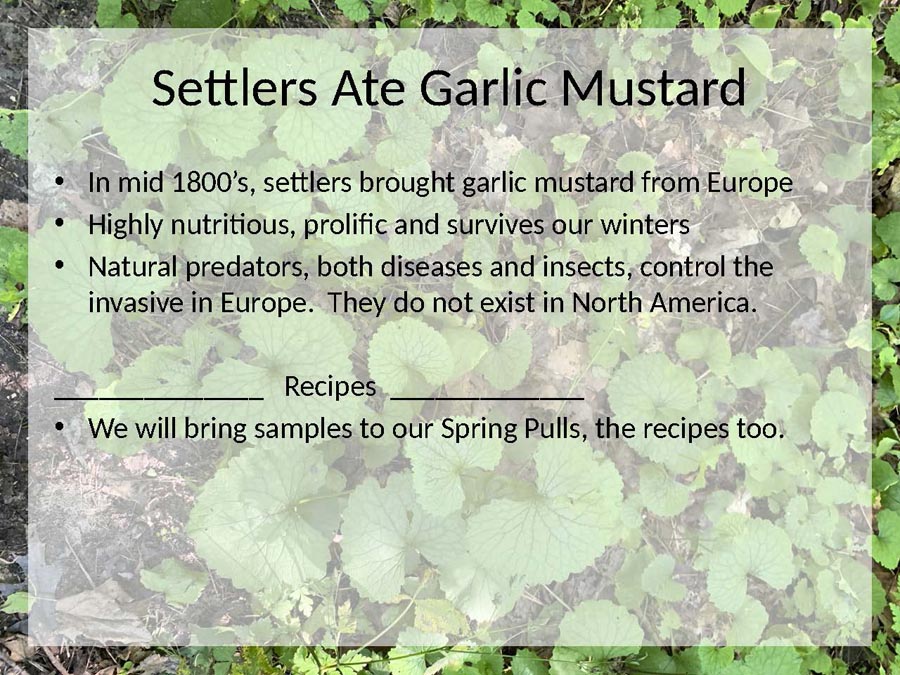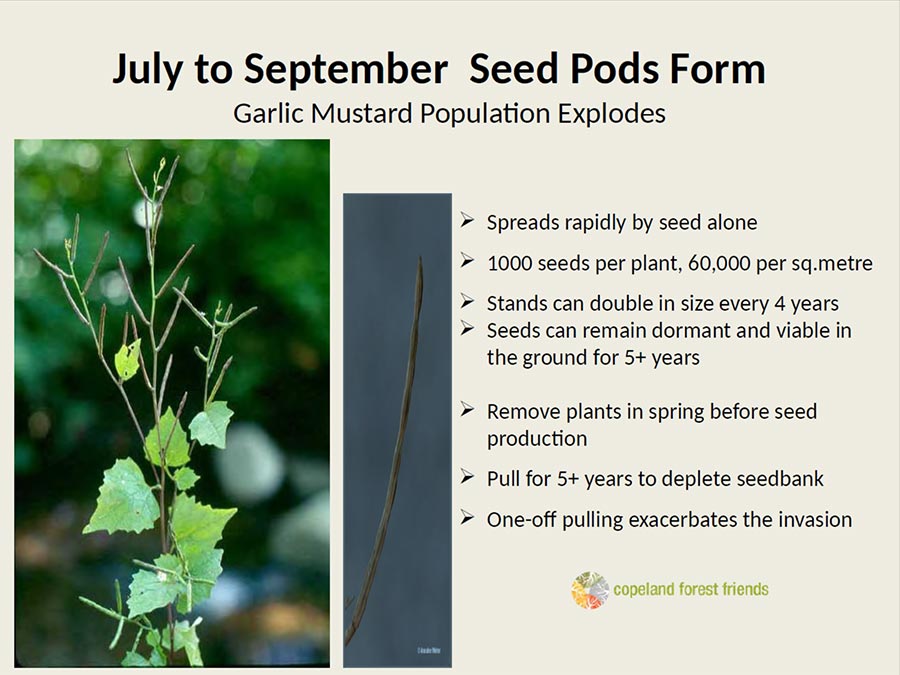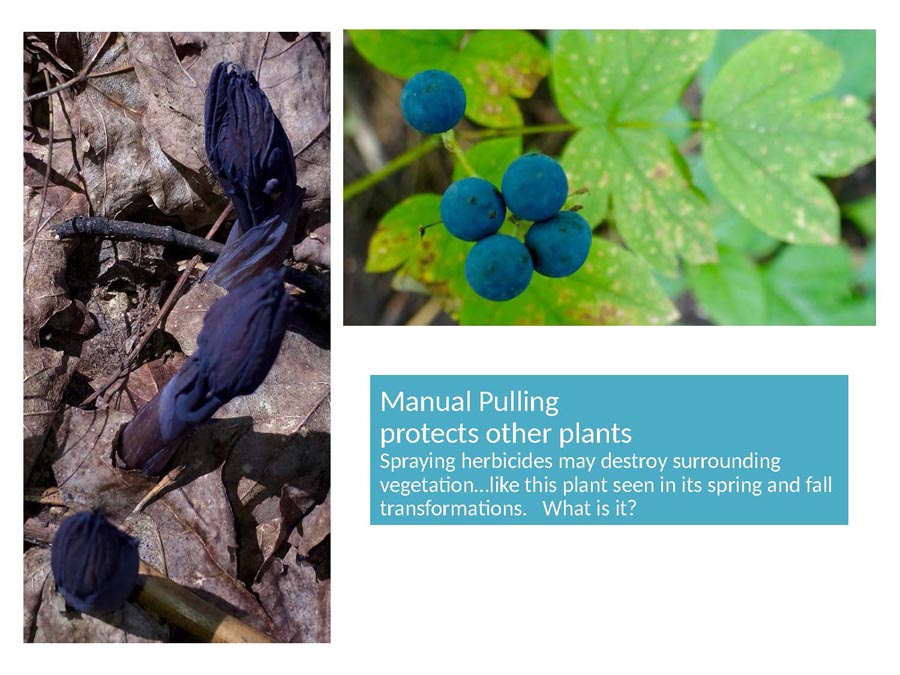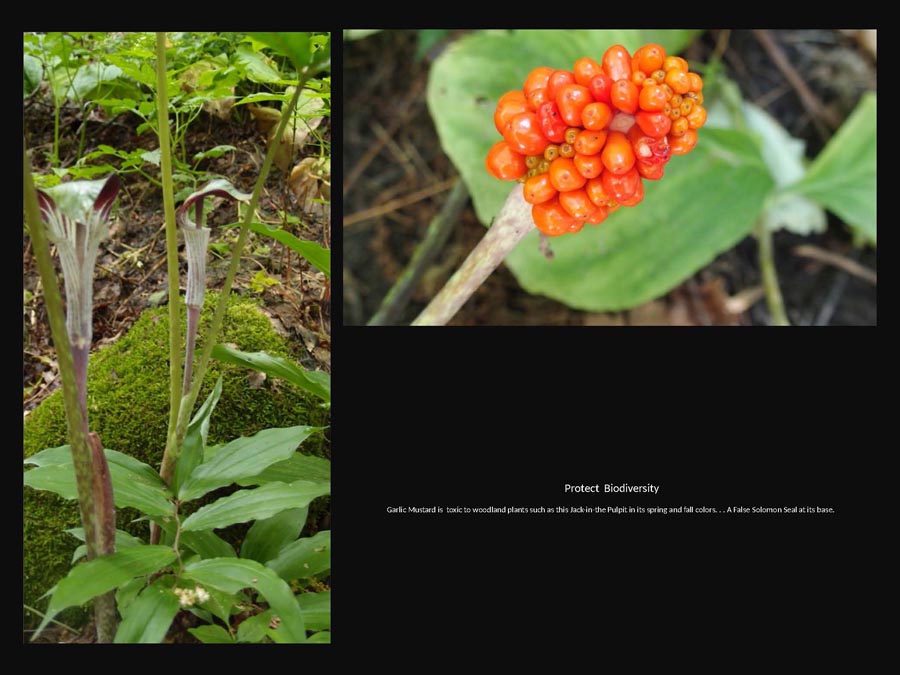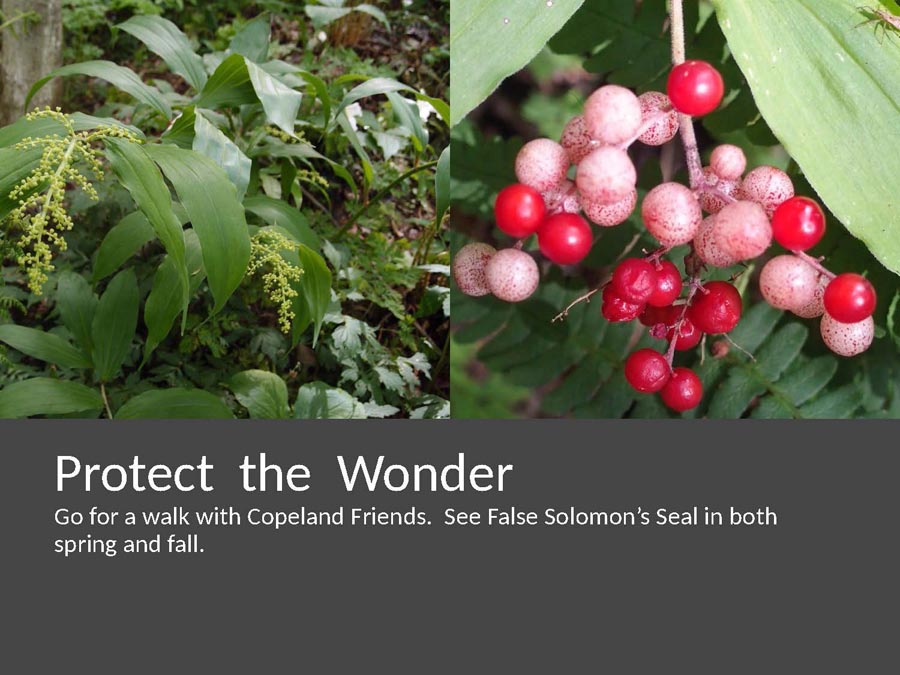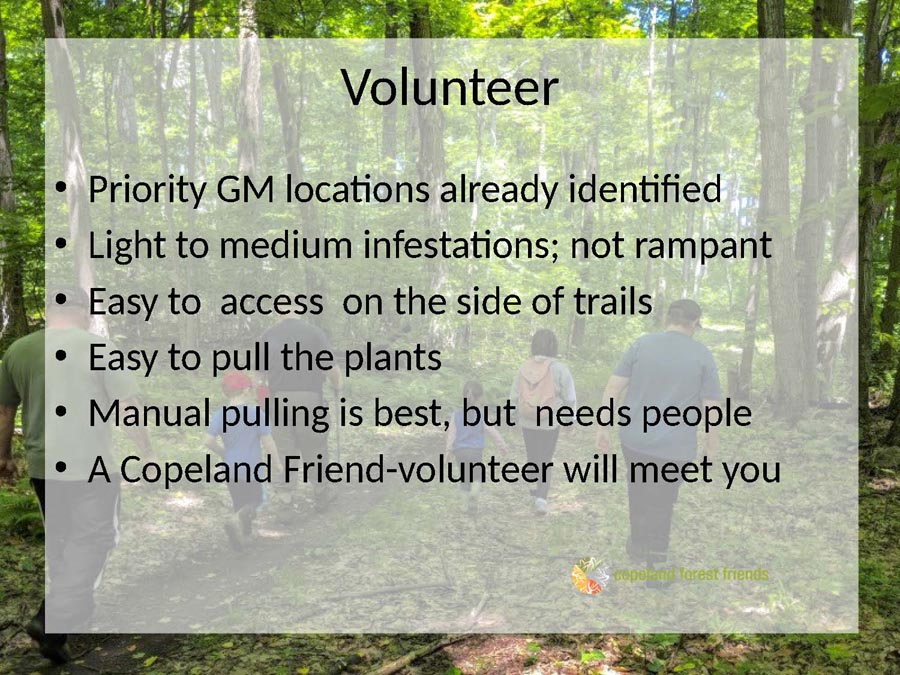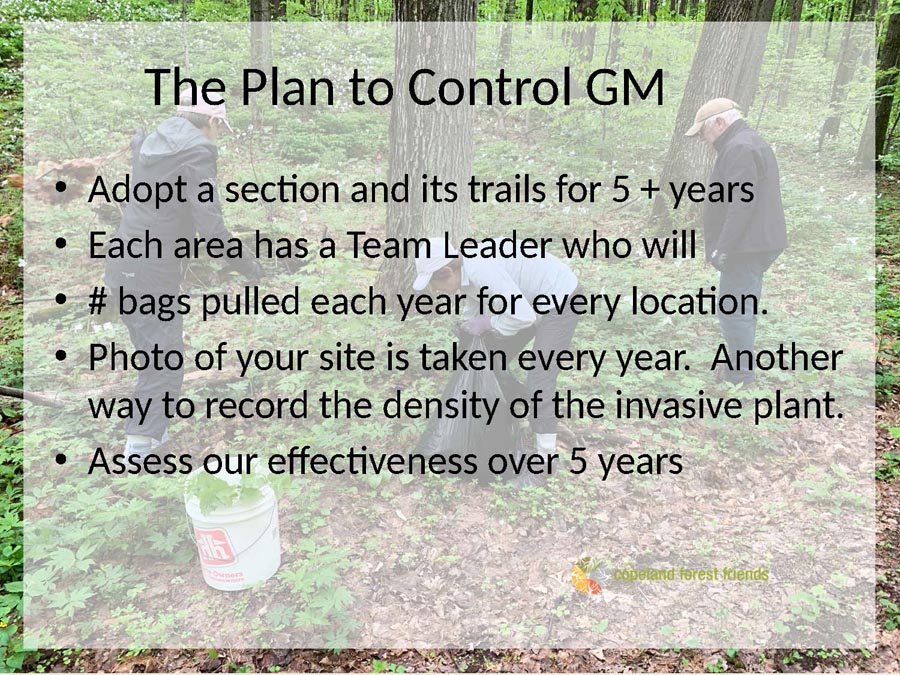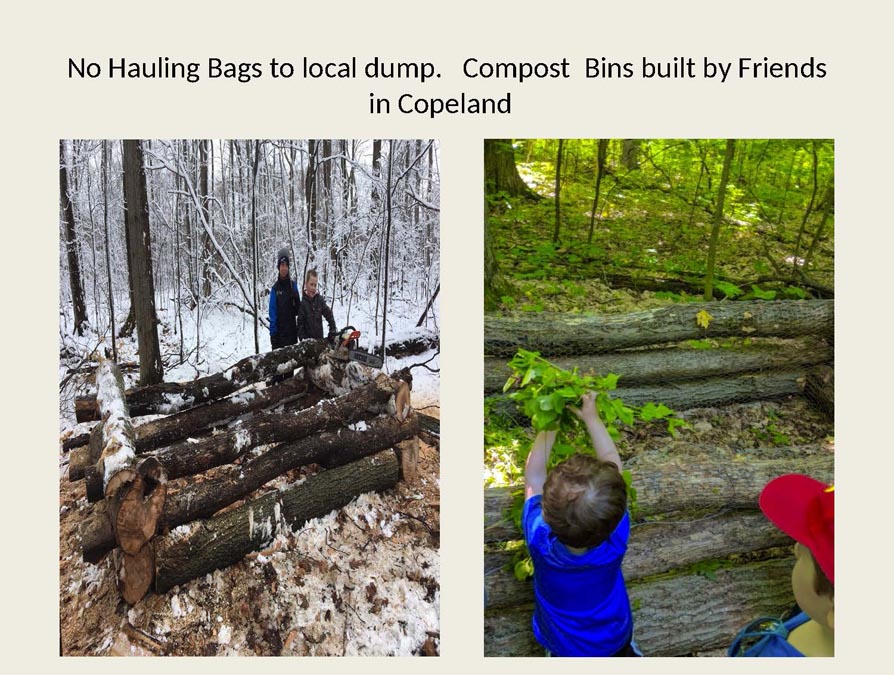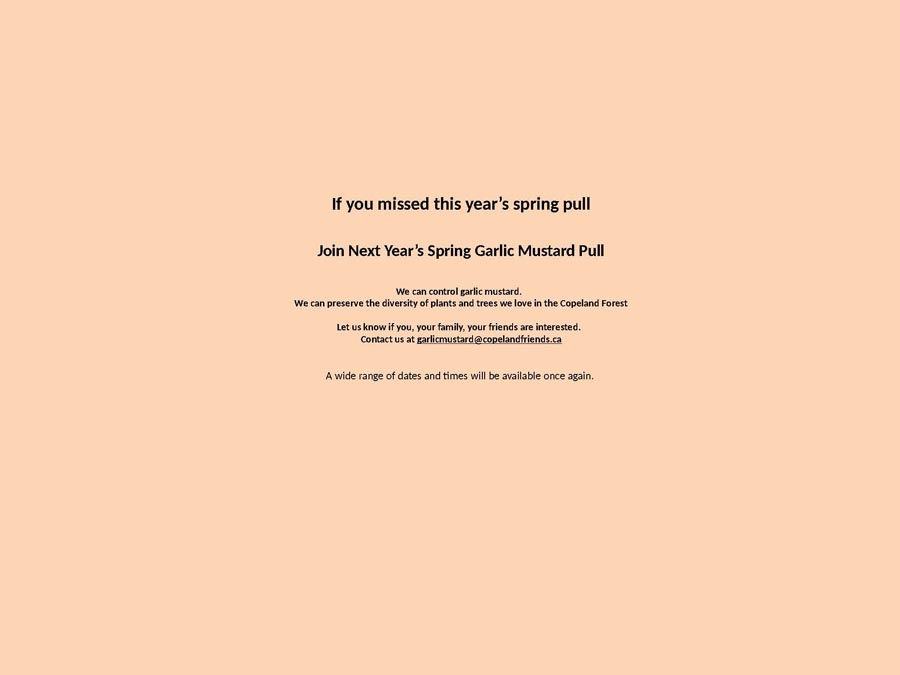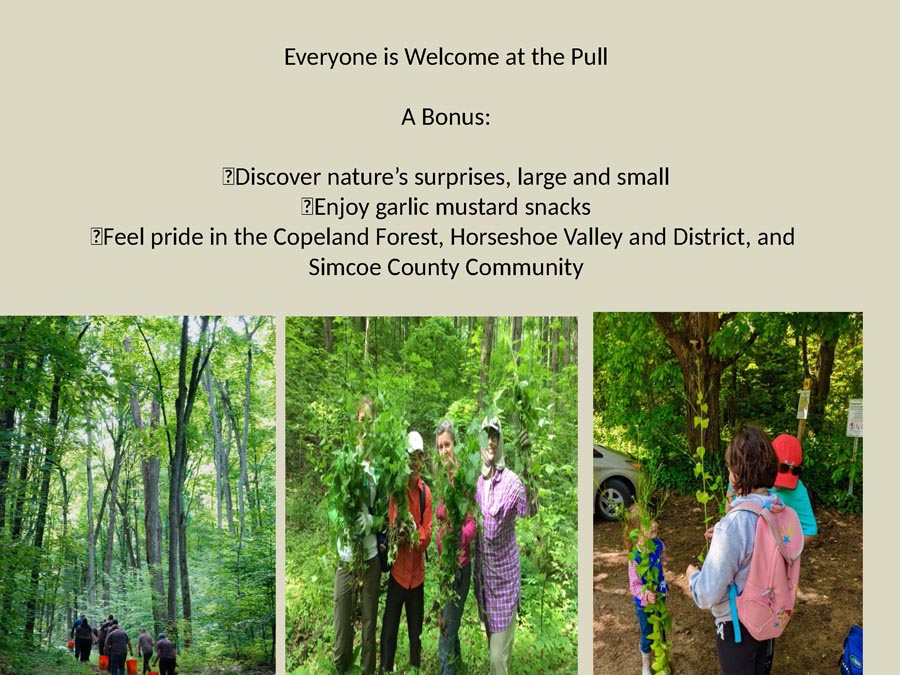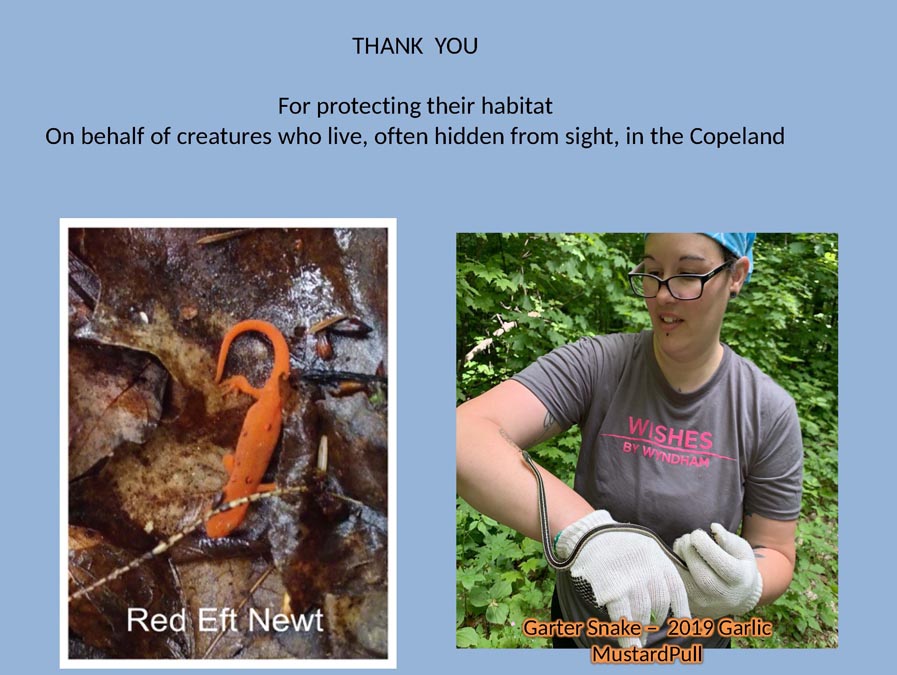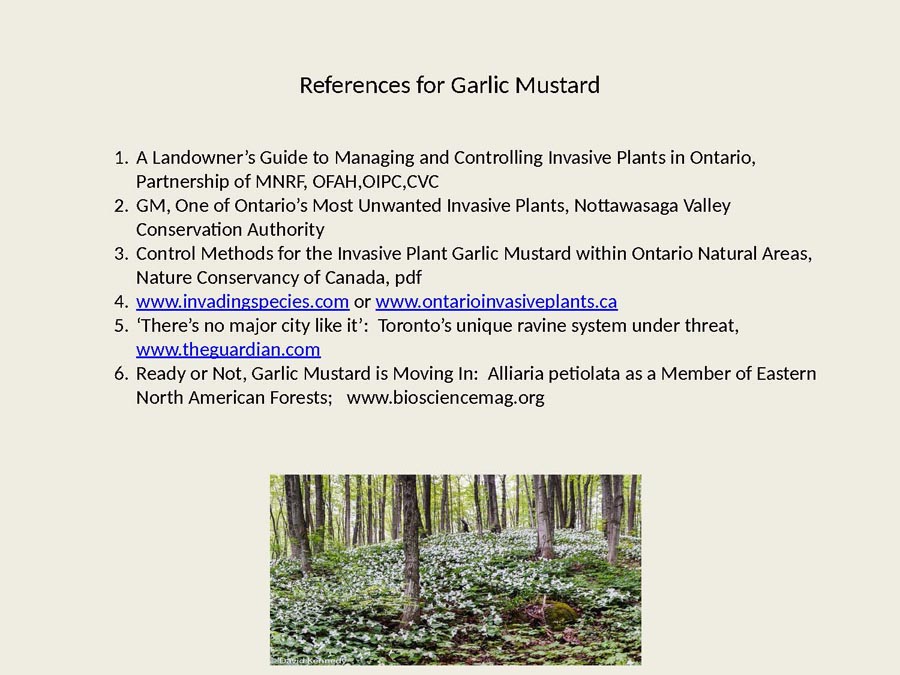Garlic Mustard
The Copeland Forest is Threatened by the Invasive Garlic Mustard
Garlic mustard has increased over the last fifteen years in the mature deciduous upland part of the Copeland Forest. Garlic Mustard spreads rapidly, eventually dominating the ecologically rich forest understory. The garlic mustard root releases toxic chemicals reducing up to 75% of nutrients going to woodland plants, even to maple, oak and beach saplings. The tall canopy trees needed to nourish habitat for future generations of animals and plants in the Copeland are in danger.
We all have the power to change this forecast.
For more information on the impact of garlic mustard and what we are doing about it, please look at our Garlic Mustard slideshow. Click through the show below by swiping left:
2025 Garlic Mustard Project Update
Would it ever appear? Late April into early May the team captains scouted their areas for Garlic Mustard plants, deciding where and when team members would start pulling. However, barely any of our sought- after invasives appeared. Copeland’s early ephemerals like Spring beauties and Hepatica came in abundance, then Red trilliums covered the hills as never before, but Garlic mustard remained scarce.
Why didn’t more seeds from a 30 year old seedbank germinate? Surely enough snow fell to provide spring moisture. Well, we will accept the Garlic mustard’s shyness with gratitude. As a result we did not have to call upon all of last year’s volunteers who were already exhausted after digging out from record snowfalls.
Pre-spring, the Copeland Forest and Oro-Medonte found itself at the epicenter of a disastrous ice storm. People chainsawed trees on their own properties, cleared trails all over Simcoe County and in the Copeland Forest, yet some volunteers still came out to remove this year’s modest crop of Garlic mustard. For that level of dedication we are forever grateful. Thanks to them the Copeland Forest has a vibrant forest floor, not a sterile monoculture of invasives.
Most appreciative of this biodiversity, though, are all the pollinators, bees, wasps, moths, flies and ants that we saw gathering pollen and nectar from the vast array of wildflowers. Did you notice that the birdsongs were noticeably louder and more varied this year? They had a variety of insects to feast upon! Oh, and the toads everywhere had full bellies too.
Next year look for a new opportunity where one or more individuals can adopt a tiny spot and pull where Garlic mustard wants to advance into an especially ecologically rich area. Monitor your satellite site when you walk your dog or do mindful meditation. Large Garlic mustard teams will also always be an option.
Thank you to all those who led and inspired teams this year. And, thank you to all of you who pulled Garlic Mustard plants. You are the best
Margaret Kennedy
Year 3 Report – 2021
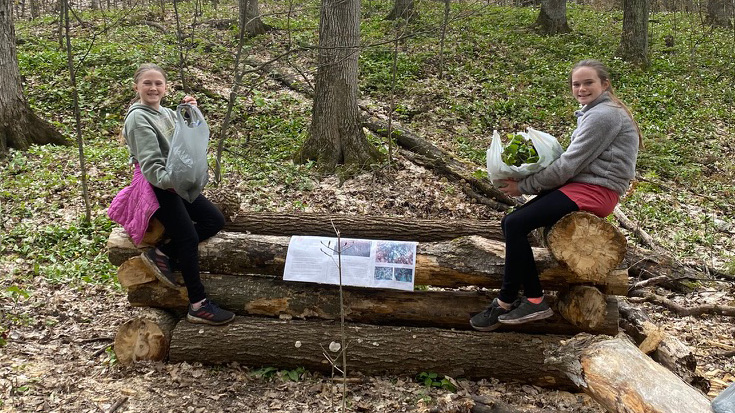
Copeland Friends Spring Garlic Mustard Pull:
Saving Habitat
The Copeland’s famous wildflowers burst on the scene with snow still on the ground. Garlic Mustard stalked the spring ephemerals just a few weeks later. But we were ready to defend the forest greenery against the invader.
This year we divided the Copeland’s upland forest into five areas, each with a Team Leader armed with 30 plus new volunteers to add to the Friend’s already seasoned experts. In this second year of the Covid-19 pandemic, we proved that having multiple leaders allowed us to involve more community people either as individuals or in very small groups. It was incredible to see the teams reacting with swift precision to keep on top of the invasive plants as they matured in waves.
As Garlic Mustard grew from babies to rosettes to flowering plants, the Teams identified the culprits and zeroed in for removal. Reconnaissance missions took volunteers well off the trails this year into the forest to snag plants before they went to seed.
With the fragrance of garlic in the air, four gigantic compost bins filled up and up again, fermented and sagged. As with wine making, we leaped in, crushed the harvest and pitch forked the plants over.
Results: Millions of Garlic Mustard seeds were prevented from future destruction of the Forest’s ecosystem. Since plants also generate from a decade-old seedbank, we will destroy them too as they appear over the coming years.
Thank you to all the Volunteers and Team Leaders. By pulling Garlic Mustard you fulfilled one recommendation from a 2013 biologist’s report on the Copeland Forest: ” Remove this invasive and keep healthy this one intact, forest ecosystem that is an excellent habitat for breeding amphibians, birds, plants seeds and trees.”
We look forward to seeing you again next spring as we chat, pull garlic mustard and find wildflowers along the way.
Year 2 – 2020
Garlic mustard grew as never before in this pandemic year. Congratulations to the 40 volunteers who tackled it with unparalleled tenacity.
Early on people emailed us and wanted to start removing the invasive plants either individually, with family members or with friends and physical distance. When we contacted those who pulled last year, 40 jumped right in, picked up a map and set off to combat the invasive. Sometimes the trail they adopted last year was changed to another area in the Forest, which was more accessible or where Garlic Mustard was more intense.
Compared to last year’s crop, garlic mustard plants this year grew abundantly. The three large compost bins were filled repeatedly as volunteers continually returned to remove the plants that developed at different stages. The encouraging news to keep in mind is this. If one plant can produce up to 1200 seeds, together we prevented millions of seeds being added to the seedbank on the forest floor.
A Shocking Discovery:
In the upland areas we thought Garlic Mustard was located just on the side of trails sometimes up to 20 feet into the forest. But on one of the Copeland’s most beautiful, valley-edge trails, also known as Michelle Special, The Five B’s, Maui Wowie, Tony Peckham of the Barrie Ganaraska Hiking Trail Association (GHTA) discovered a disaster. Garlic Mustard spread across the expansive hillside and down 100 feet towards the lush, moist valley bottom. 50 hours of dedicated manual labor, the rescue of this fragile ecosystem from the invasive has just begun.
The Copeland’s Diverse Ecosystem is Under Attack:
NO other plants survived on the forest floor where healthy Garlic Mustard plants as tall as a person’s shoulder had taken over this lush slope. Garlic Mustard had eradicated 10 different plants and saplings. The future diversity of plants and trees is at risk if we do not take action.
Thank you to everyone who helped in 2020. For those who couldn’t join us in 2020, we look forward to seeing you for the 2021 spring campaign. We will be in touch with all of you. This year we will have leaders in different areas to make sure everyone is informed and comfortable in this large forest.
2021 Garlic Mustard Removal will start early in spring, safely distancing outdoors along with the beautiful spring wildflowers. If you haven’t taken part in this annual event with friends of the Copeland Forest, contact us at garlicmustard@copelandfriends.ca
Year 1 Report – 2019
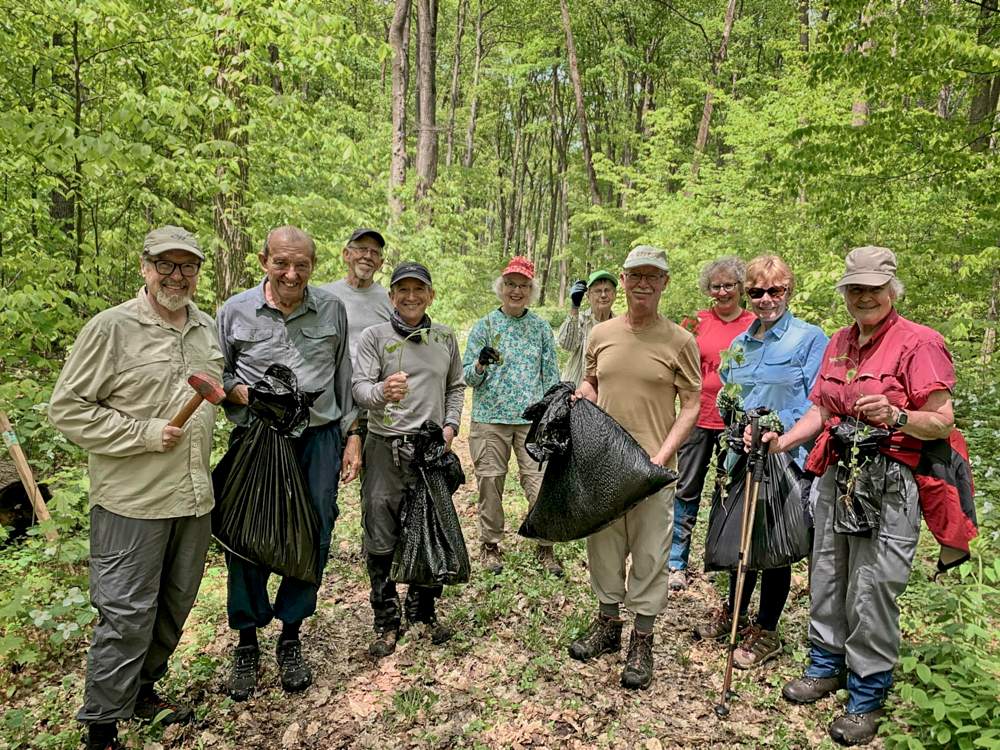
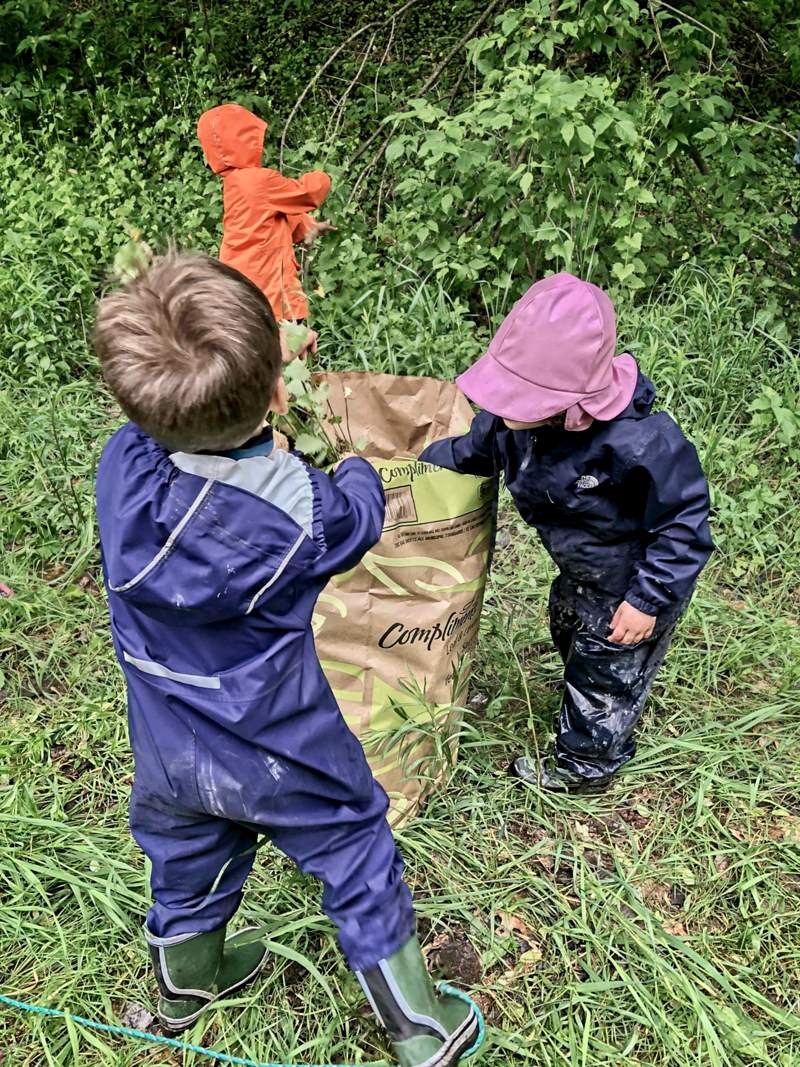
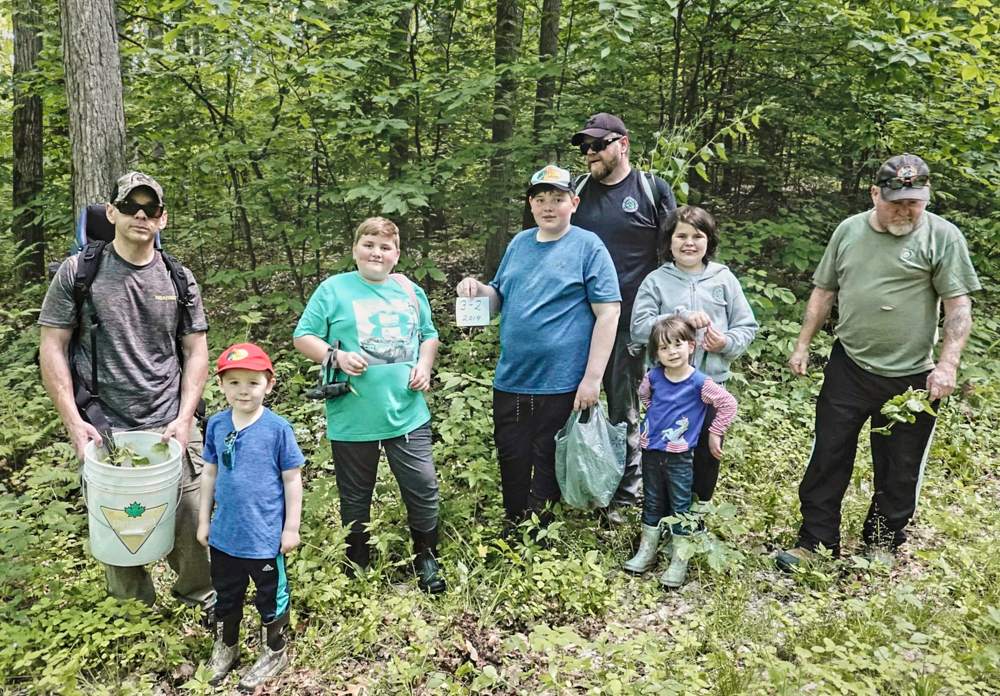
We had huge successes for the first year of an ambitious campaign to control garlic mustard in the Copeland Forest. An amazing hundred people volunteered. They adopted a trail and committed to pull garlic mustard for five years. With this significant turnout, we were able to pull all of the Copeland Forest’s upland, deciduous Forest, the most biodiverse area.
The volunteers came as individuals, couples and small groups. They came from Horseshoe Valley and vicinity, from Barrie to Coldwater to Midhurst. All ages and users volunteered from extreme runners to people new to the Copeland Forest. All were passionate about preserving the natural beauty of the Forest.
We also had many organized groups come forward to volunteer. They included the Barrie and Oro Medonte Ganaraska hiking clubs, the Barrie and Georgian Bay Anglers and Hunters Youth Conservation clubs, the Oro-Medonte Forest School, Wyndham Destinations Carriage Hill’s Resort staff.
Garlic mustard pulls are hard work, but we also had fun. Everyone enjoyed discovering wildflowers as we walked to the pull sites. Before heading back garlic mustard snacks brought everyone together to chat. Some pulled plants were even taken home to make the recipes.
We had many challenges to overcome. First, the garlic mustard plants were slow to grow this cold damp spring. People who chose to pull in mid-May (perfect timing for last year) were rescheduled for late May or June. Flexibility was key.
We also did not have a bumper crop of garlic mustard this year. Locations of garlic mustard plants were more scattered and lighter in density this year. So, patience was required to find the plants and to revisit the same sites to see if new plants had shot up. This phenomenon has occurred before. Next year the garlic mustard may come back with a vengeance judging by the number of baby plants that sprouted this spring and will mature in 2020.
Of course, the Copeland Forest itself can be challenge. It’s a very large, hilly forest to tackle. Knowledgeable leaders guided people to their pull locations, plus individuals got personalized maps with their trail color-highlighted and a stake on the trail with their ID label marking their section.
We kept track of results this year. Pull data for 2019 was recorded and will be collected for five years. Number of bags put in the compost bins and photos of plants growing helped record the density.
A heartfelt thanks goes out to all the volunteers who dedicated their time, energy and passion to protecting the Copeland Forest’s natural habitat; to MNR&F and the CFFA board who supported the project and to Margaret Kennedy and Clare Holden who led and inspired the campaign.


